ClarkVision.com
| Home | Galleries | Articles | Reviews | Best Gear | Science | New | About | Contact |
Pixel Size, ISO and Noise in Digital Cameras
by Roger N. Clark
| Home | Galleries | Articles | Reviews | Best Gear | Science | New | About | Contact |
by Roger N. Clark
Introduction
With a lot of cameras coming out lately with wildly different sized pixels, there are more choices than ever, and seemingly more confusion than ever. Large pixels alone do not improve high ISO noise performance. With the same lens at the same imaging position, larger pixels have less pixels on the subject, thus each pixel sees a larger area, which gathers more light, but there is less detail in the image. If you had very small pixels, one could average pixels together and improve signal-to-noise per pixel by trading detail and noise. Less noise and less detail, or more detail with more noise. So which to choose, a camera with larger pixels or smaller pixels?
Before we start, some notes about ISO. ISO does not change sensitivity, it only tells the range to digitize. Digital cameras have only one sensitivity. When you increase ISO, the computer tells the camera to decrease the exposure, for example, by shortening the exposure time. The shorter exposure means the camera receives less light at the sensor, so that weaker signal is then amplified more. If ISO 100 digitizes the full range of the pixel (like a full bucket of water), then ISO 200 digitizes up to half (like a half full bucket). Then ISO 400 digitizes only 1/4 capacity, ISO 800 only 1/8 capacity, and so on. The signal-to-noise ratio of light is the square root of the number of photons collected, so as the camera collects less light, the signal-to-noise ratio drops. It is that less light that results in the noisier images we observer in high ISO digital camera images. High ISO on a digital camera simply tells the camera to reduce true exposure. See ISO Myths and Digital Cameras for more information about what ISO really is (it does not change sensitivity).
A second, but a much lower factor, is fixed pattern noise and sensor read noise. See Digital Camera Sensor Performance Summary for more details.
Below I show a series of images taken with 3 cameras, each with different sized pixels. The subject (the Moon) was small in the frame, so this is a focal length limited situation. I used a 300 mm f/2.8 lens on the 3 cameras. The exposure = 1/ISO at f/5.6 on each camera. So each sensor received the same amount of light at a given ISO. The 3 cameras have 4.3, 5.7 and 6.4 micron pixels. The 6.4 micron pixel images have the highest signal-to-noise ratio, but the least detail. The images were converted from raw with identical settings on all images.
Examine the series and evaluate which camera produces the best image at each ISO for this condition. The test illustrates the trade between pixel size and detail as apparent noise increases with increasing ISO (making shorter exposure times). The series applies to conditions where you use the same lens on cameras with different sized pixels and photograph the subject from the same location. Two general conditions meet this example: 1) same sized sensor with different sized pixels, and 2) different sized sensors with different sized pixels where the subject is small in the frame. This second case is common in telephoto photography where the subjects, e.g. a bird, is at a distance where it is small in the frame.
With the Canon 1DX and Nikon D4 we have a choice of very large pixels and with cameras like the Canon 7D and Nikon D800, a choice of very small pixels. But for people in focal length limited situations (many bird photographers have this problem), should one buy a larger pixel camera or a smaller pixel camera?
The Moon as a test target is a very tough subject. There is color in the Moon, and there is a complete range of contrast, from very high (the craters on the terminator), to very low (sunlit areas away from the terminator). Note the subtle color variations in the basalt flows in the maria (the dark areas on the Moon). Note too, how those color differences are lost as ISO increases (shorter exposure times resulting in less light being recorded).
The sensor sizes are irrelevant in these examples. All three cameras could well have been full frame sensors. It is purely a test of pixel size and the trade of detail versus noise. Different people will have different opinions on which image at a given ISO is better for them. There is no one right answer.
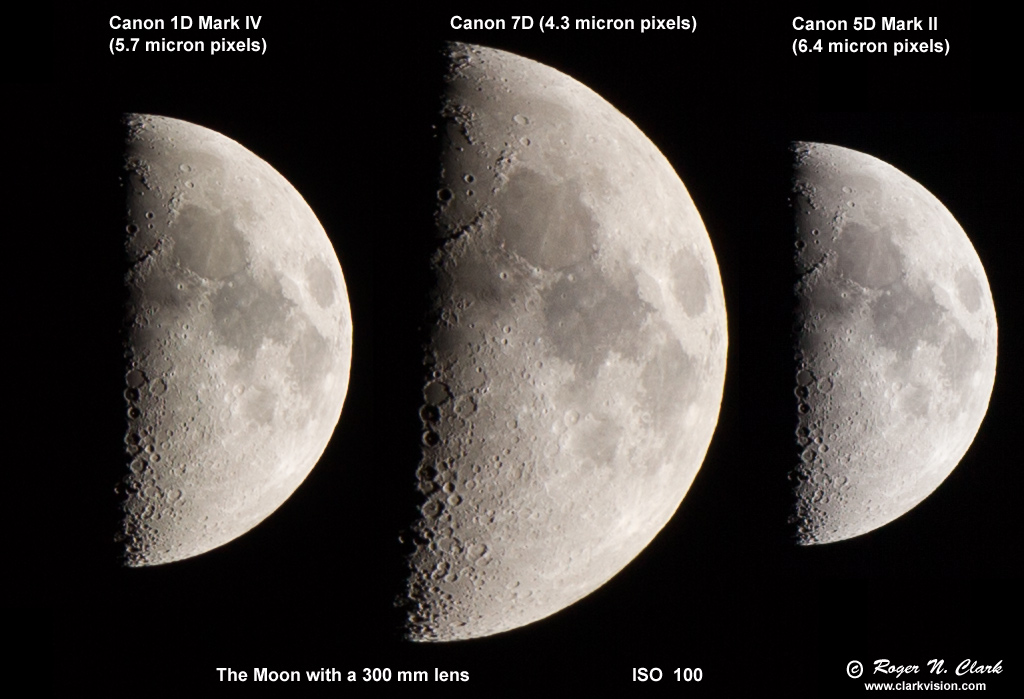
Figure 1. ISO 100
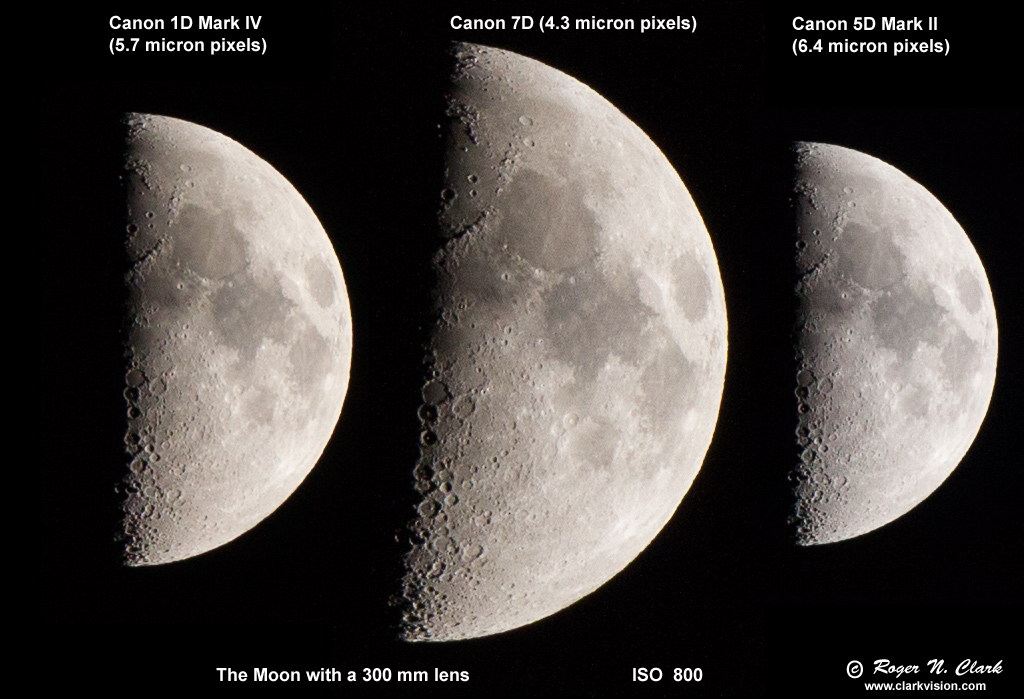
Figure 2. ISO 800
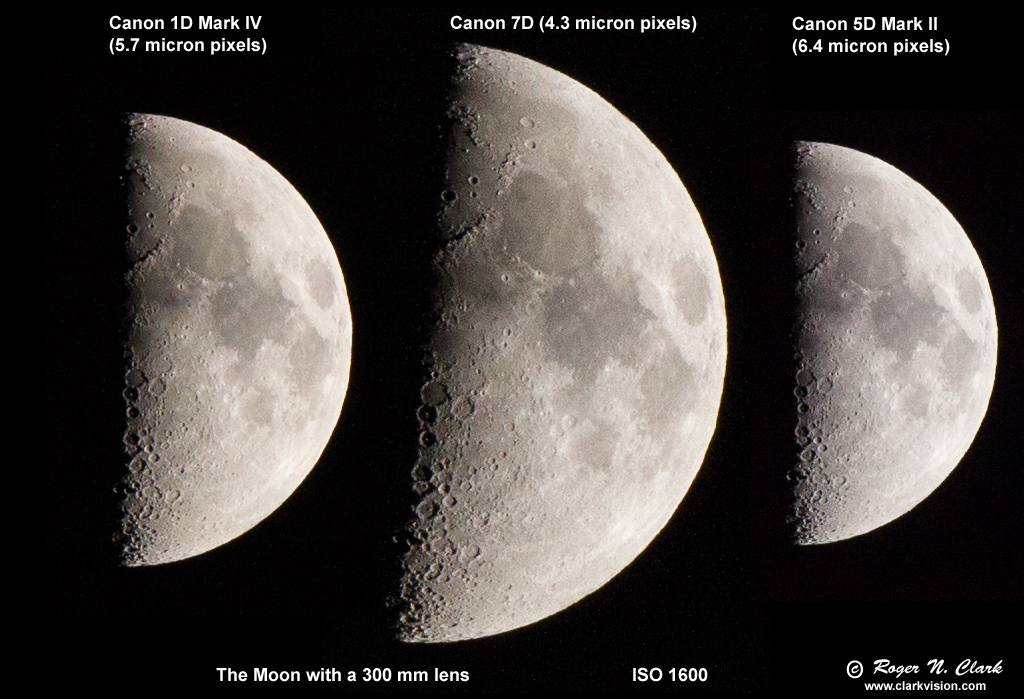
Figure 3. ISO 1600.
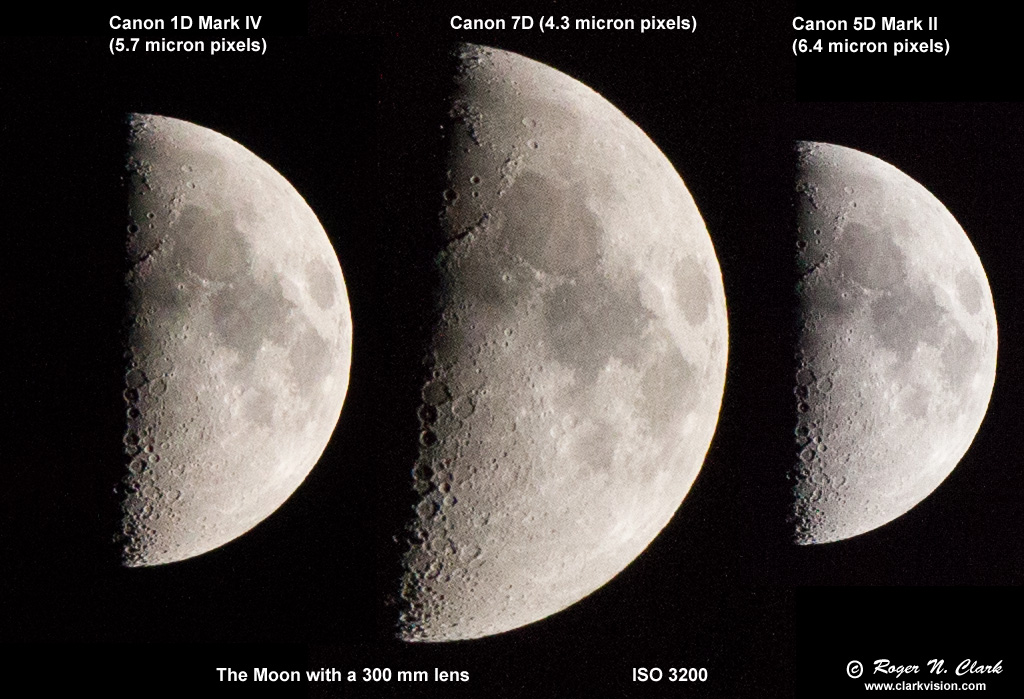
Figure 4. ISO 3200.
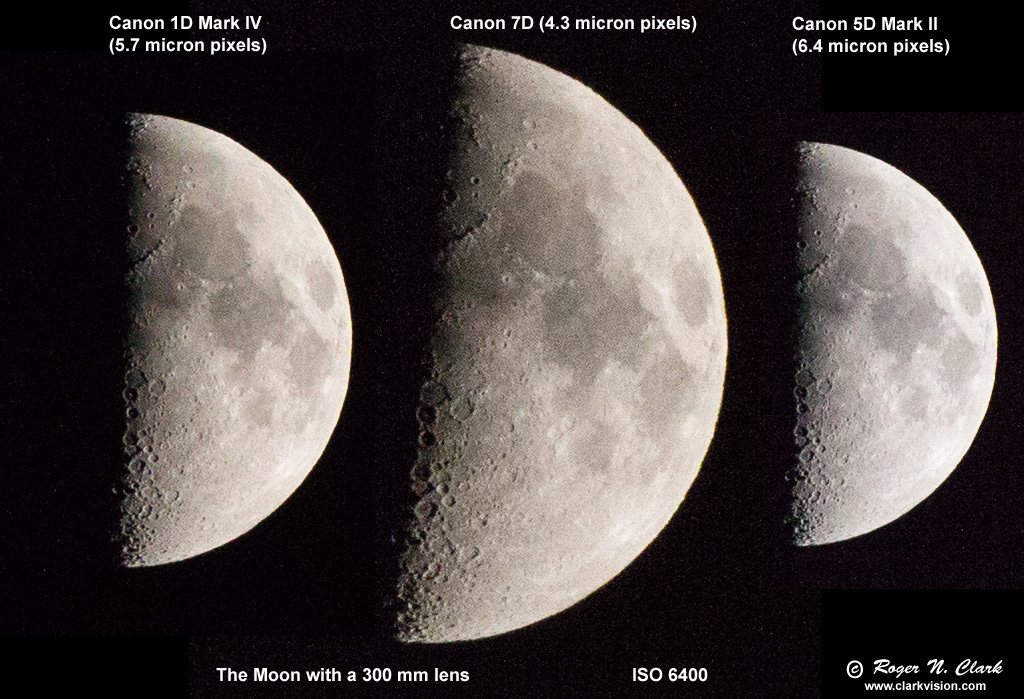
Figure 5. ISO 6400.
Here is my assessment:
In all the images, the 5DII images fail to show the subtle color differences that the 7D and 1D4 show. The color in the 1D4 and 7D are very close (until noise hides it).
ISO 100: 7D noise is small and detail is well above other images. 7D=top, 2nd=1D4
ISO 800: 7D noise is showing, but the detail is still well above the other cameras. 7D=top, 2nd=1D4
ISO1600: 7D noise is becoming prominent, but image detail is still very good. 7D=top, 2nd=1D4, but the difference is narrowing.
ISO3200: 7D noise is becoming objectionable and color is getting lost, in particular in Mare Serenatatis (the large circular dark area in the upper center). top=1D4, 2nd 7D. A good down sampling algorithm (like 2x2 pixel average) could improve the the image.
ISO6400: Noise is too apparent in 7D, and 5DII (which is slightly older technology than the 7D or 1D4). Top=1D4, 2nd=5DII. In my numerous sensor evaluations, I consistently see the 1D series sensors have fewer hot/bad pixels and the images here show that too: the 7D and 5DII images have a lot of "spiky" noise not seen in the 1D4 image.
In all the images, if we boost the low level, we will see that all the 7D and 5DII images have a lot of fixed pattern noise, which decreases as ISO increases. The 1D4 has a little fixed pattern noise at low ISO which quickly decreases at intermediate ISOs. The noise is illustrated below.
Averaging Pixels to Reduce Noise
An example of averaging 2x2 pixels is shown in Figure 6. At ISO 6400, the 7D image is looking pretty ratty, but a 2x2 average really cleans things up and produces a very sharp pretty low noise image. The detail is close to that of the 5D mark II, perhaps better in some areas. If the 7D were full frame with 4.3 micron pixels, then the full image would be 46.7 megapixels, and 2x2 averaged would be 11.7 megapixels. Such a camera would give excellent high ISO performance and fine detail when needed.
Color noise is a lower frequency than luminance noise, so 2x2 pixel averages would have less effect on color noise. But even so, we see that the color noise in the 2x2 pixel averaged image in Figure 6 is much reduced, and significantly lower than the noise from the 5DII.
A stretched version of the images in Figure 6 is shown in Figure 7 to show the low end. It shows that the noise in the 2x2 pixel average, both luminance and color is less than that from the 5DII, as one would expect. A 2x2 average of 7D pixels gives an equivalent pixel size of 8.6 microns, so larger than the 5DII pixels, resulting in better signal-to-noise ratios, thus our perception of lower noise. This is a good example of how larger pixels produce images with less apparent noise (higher signal-to-noise ratio).
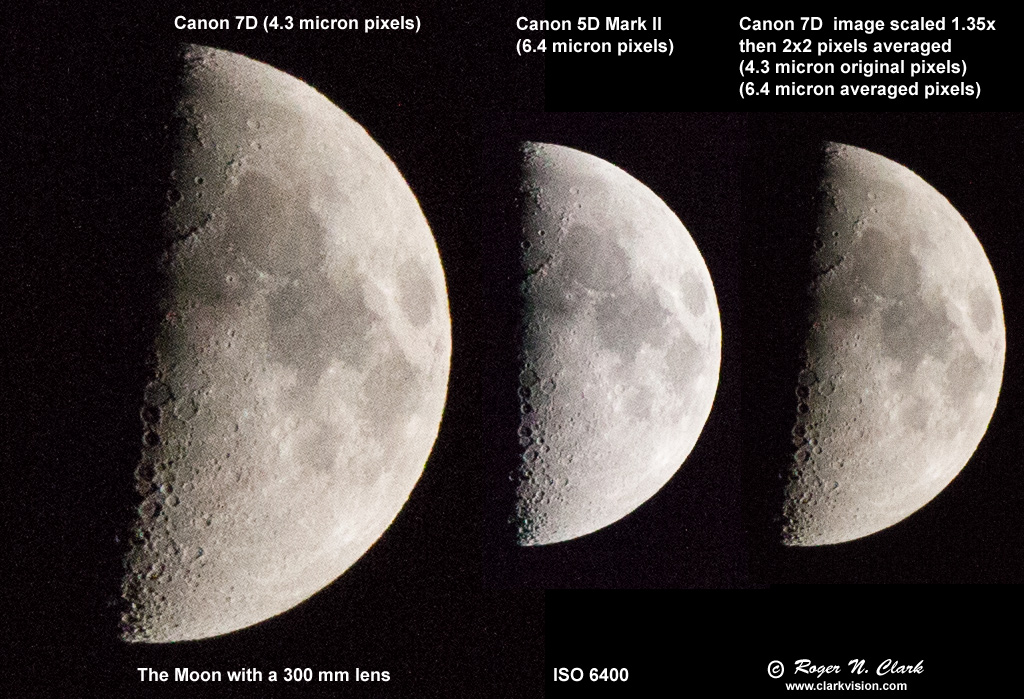
Figure 6a. Comparison of 7D, 5DII and scaled 2x2 pixel averages of the 7D
image at ISO 6400. The 2x2 pixel average was performed in ImagesPlus. This
rescaling and pixel averaging make the image the same size as the Moon in
the 5D Mark II image. If the two cameras had equal system sensitivities,
the noise would be identical. The rescaled 7D image on the right actually
shows less noise than in the 5D Mark II image because the 7D has greater
system sensitivity. No sharpening and no noise reduction software was
run on any image.

Figure 6b. Comparison of 7D, 5DII and 2x2 pixel averages of
the 7D image at ISO 6400. The 2x2 pixel average was performed in ImagesPlus.
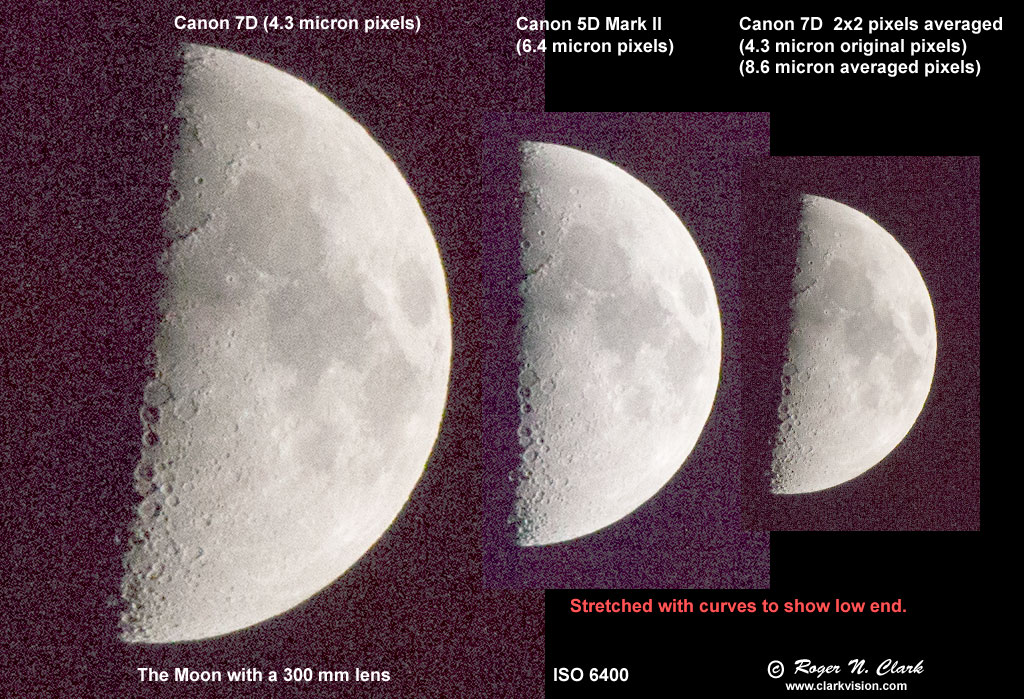
Figure 7. Image from Figure 6b stretched at the low end to show
the noise.
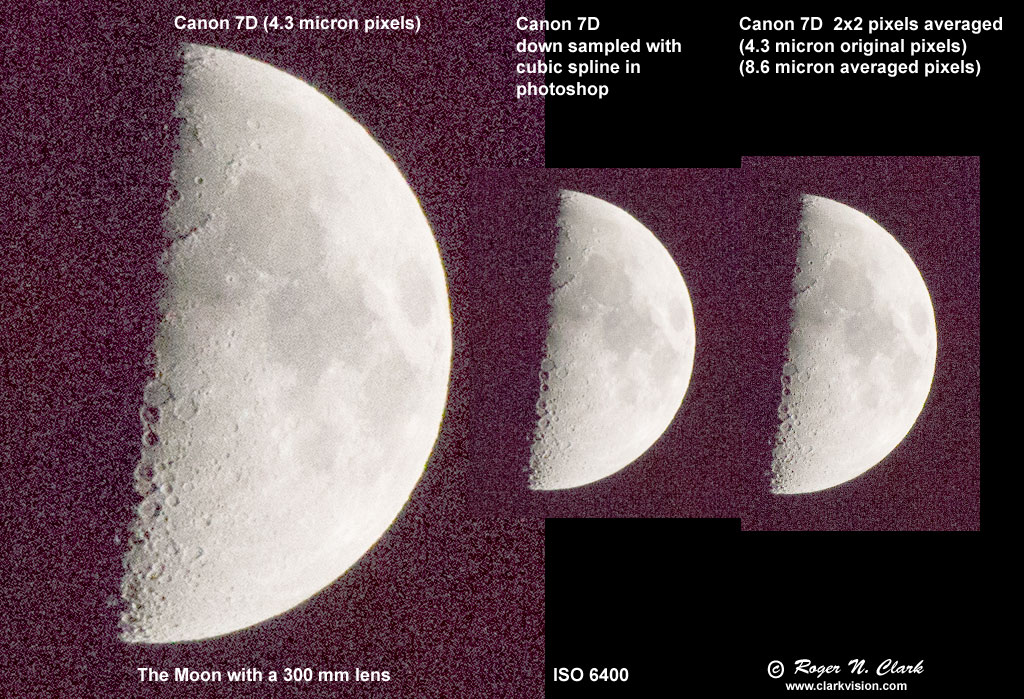
Figure 8. Image data from Figure 7 with a comparison of bicubic
resampling in photoshop, compared to simple 2x2 pixel averaging, and stretched
at the low end (similar to that in Figure 7) to show the noise.
The cubic spline reduces the noise but produces a softer image. Many photographers
then apply unsharp mask to restore the apparent sharpness, but that increases noise,
resulting in a worse outcome than simple pixel averaging.
Conclusions
The bottom line in my opinion: given a focal length limited situation and desire for as much detail as I can get, a camera with small pixels, like the 7D is the what I would choose. Not shown in the test, but given a non focal length limited situation where you can change position to get the subject to fill the sensor, a larger sensor (e.g. full frame) with the most pixels is the what I would choose. But if money were not an object, a compromise pixel size is a good option, if one chooses a high quality sensor like those in pro-series cameras.
With a small improvement in pixel efficiency implied by the latest camera announcements, pixels a little smaller than the 1D4 with the same signal-to-noise ratios as the 1D4 pixels in a full frame sensor would be ideal, something like 5-micron pixels (thus 34.5 megapixels). Such a camera would have both low ISO fine detail and high ISO performance by pixel averaging.
Additional Reading
Crop Factor and Digital Cameras
Digital Cameras: Does Pixel Size Matter? Factors in Choosing a Digital Camera (Does Sensor Size Matter?) Good digital cameras are photon noise limited. This sets basic properties of sensor performance.
The f/ratio Myth and Digital Cameras.
Etendue, or Optical Throughput.
| Home | Galleries | Articles | Reviews | Best Gear | Science | New | About | Contact |
http://clarkvision.com/articles/pixel.size.and.iso
First Published March 3, 2012
Last updated July 14, 2012.